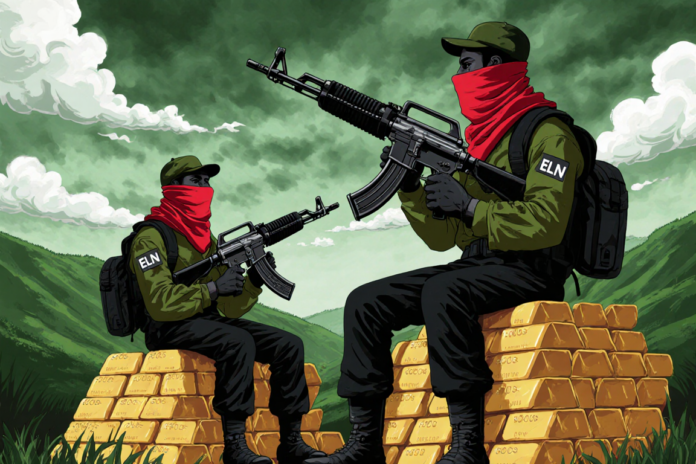
In the gold-laced folds of a mountain range that cuts through Sur de Bolívar, more than 7,500 people have been locked inside their homes for nearly three weeks, caught between two warring factions in a deepening humanitarian crisis. With schools closed and food growing scarce, the National Liberation Army (ELN) guerrilla has turned the mountainous San Lucas range into a battlefield for a chilling form of warfare: drones.
Over 18 days of clashes between the ELN and paramilitary Gaitanist Self-Defense Forces – known also as the Gulf Clan – Colombia’s security forces have also come under attack, not just from direct fire and roadside explosives, but from above. The ELN’s deployment of drones fitted with explosives recently injured six soldiers and killed another in southwest Cauca, marking a dangerous and unprecedented escalation in the country’s armed conflict.
Aerial attacks are just one tool in the ELN’s broader strategy to seize control of San Lucas and the artisanal gold mines that extend along the southern ridges of a department whose capital, Cartagena, is 600 kms north. But unlike other turf wars between illegal groups, the violence in Sur de Bolívar now forms part of a transnational campaign that begins deep in Nicolás Maduro’s Venezuela. Intelligence sources suggest the ELN is attempting to forge a mineral corridor stretching all the way from the Orinoco River, across the central Andean departments of Santander, Boyacá and Antioquia, to the Pacific coast.
This strip – rich not only in gold, but also rare earth minerals, timber, and cocaine trafficking routes – is rapidly becoming the backbone of the ELN’s war economy. In recent months, the group has expanded aggressively, bringing it into increasingly violent confrontation not just with state forces, but with FARC dissidents and other criminal groups.
The conflict in Sur de Bolívar is a stark reminder of what happens when peace initiatives falter and the state retreats. President Gustavo Petro’s “Total Peace” plan has failed to dismantle illegal economies or deliver real security to vast swathes of a nation that for decades witnessed some degree of peace and tranquility.
“The violence was predictable,” believes Manuel Berrío, Security Secretary for the Bolívar department. “But our institutions are overwhelmed. We’ve been left alone. The military answers to Bogotá. Local governments can only ask for help – we can’t confront armed actors ourselves.”
The worst-hit municipalities – Montecristo, Arenal, Cantagallo and Santa Rosa – are barricaded. Roads are blocked, communication is cut, commerce has collapsed. More than 1,000 children have been out of school since mid-July. The national Ombudsman’s Office (Defensoría del Pueblo) has issued repeated warnings about the deteriorating humanitarian situation – including confinement of the elderly, the sick, and children who need unrestricted access to food and local health facilities.
“We urge all illegal armed groups to immediately cease actions that endanger the lives, integrity, and dignity of the civilian population,” the Ombudsman’s Office said Monday in a statement.
But the crisis in Bolívar is just one front in a broader war. According to the Ombudsman’s most recent report, over 134,000 Colombians were forcibly displaced in the first half of 2025 due to armed conflict – already more than half the 250,000 displaced in all of 2024. And there are growing reasons to believe the figures will rise as violence intensifies across central Colombia.
At the end of July, the ELN declared an “armed strike” across the western department of Chocó, banning river and road transport along the Atrato and San Juan Rivers. The move left Indigenous and Afro-Colombians stranded without access to local markets. Around 4,500 people were confined in Chocó in June alone, while in Guaviare, over 10,000 have been affected by similar terror tactics.
This was the third ELN-imposed strike this year – the first occurred in February, the second in May. In Catatumbo, near the Venezuelan border in Norte de Santander, more than 60,000 people have been displaced this year after the ELN clashed with FARC dissident Front 33. The fighting, which began in January, triggered one of the country’s largest mass displacements since the 2016 peace accord. As of 30 June, some 50,000 Colombians remain confined.
Colombia’s Defence Minister, Pedro Sánchez, has promised to increase military deployments in Sur de Bolívar and reopen critical road access. “The ELN’s drone attacks are not just tactical,” he said, “they’re part of a wider strategy to isolate communities, displace the population, and consolidate illegal mining routes.” But for many in the region, statements from the presidential palace in Bogotá ring hollow.
It is not the first time the Sur de Bolívar is making international headlines. In 1999, the ELN hijacked an AVIANCA flight and forced it to land on a clandestine airstrip in the south of the department, kidnapping all 42 passengers and crew. The high-profile stunt was designed to draw attention to the group’s demand for a demilitarized zone within the Serranía de San Lucas.
Today, the ELN no longer needs to hijack planes. It can take hostage more than 7,500 with one offensive. And with its growing drone capability, it aims to control the most vulnerable mining and farming communities with improvised technologies.
